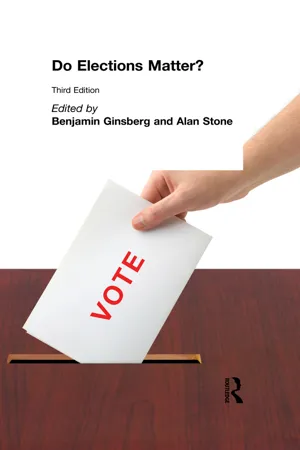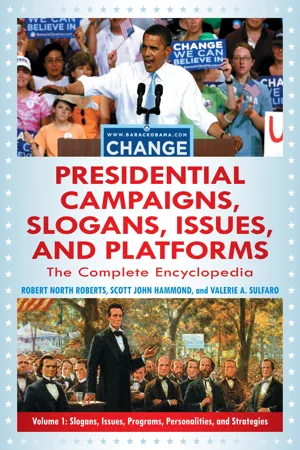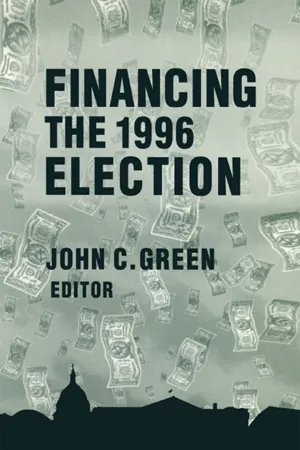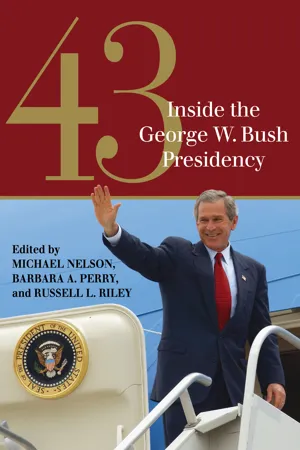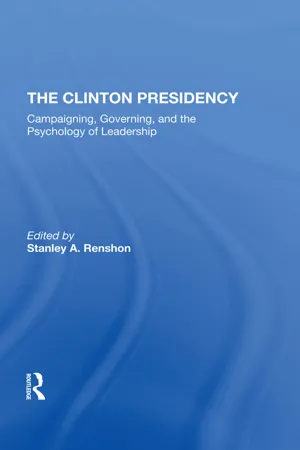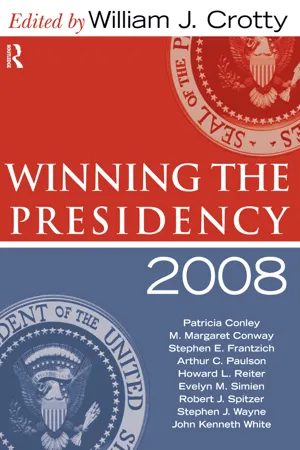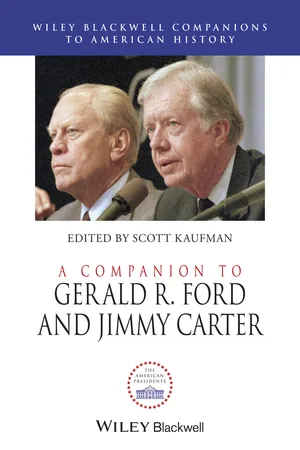History
1992 Presidential Election
The 1992 Presidential Election was a pivotal moment in American politics. It saw Democrat Bill Clinton defeat incumbent Republican George H.W. Bush and independent candidate Ross Perot. Clinton's victory marked the end of a 12-year Republican presidency and the beginning of a new era in American politics.
Written by Perlego with AI-assistance
Related key terms
Related key terms
1 of 4
Related key terms
1 of 3
9 Key excerpts on "1992 Presidential Election"
- eBook - ePub
- Harvey L. Schantz(Author)
- 2013(Publication Date)
- Routledge(Publisher)
CHAPTER 3 The Presidential Campaign and Vote in 1996Job Ratings of Presidents—and Success or Failure at the Polls
MILTON C. CUMMINGS JR.In an election year that some commentators asserted produced the dullest and least exciting presidential campaign in many decades, there were nonetheless a number of noteworthy features in the final voting returns. President Bill Clinton, the Democratic nominee, won a decisive victory over former Senator Bob Dole, his Republican opponent, and Ross Perot, the candidate of the Reform Party. Clinton carried thirty-one of the fifty states and the District of Columbia, and won 379 electoral votes to 159 for Dole. Clinton's victory marked the first time since 1936 that a Democratic president had been elected to a second full term. And he was only the fourth Democratic president in history–along with Franklin Roosevelt, Woodrow Wilson, and Andrew Jackson–to win two consecutive presidential terms.1Clinton's vote went up between 1992 and 1996; but the vote for the other presidential candidate who ran in both years, Ross Perot, dropped sharply, from 18.9 percent in 1992 to 8.4 percent four years later. Even so, Perot's 1996 presidential showing was the sixth largest vote percentage polled by a third-party or independent presidential candidate since the Civil War. In addition, though little noted, there was another sign in 1996 that many voters were not wedded firmly to the two major parties. Between 1992 and 1996, the vote for minor-party candidates for president other than Perot more than doubled.2 Those “other” minor-party tallies included close to 700,000 votes for Ralph Nader on the Green Party ticket, and nearly half a million votes for Harry Browne on the Libertarian ticket.The 1996 voting for Congress also produced an outcome that would have a powerful impact on relations between the president and Congress for at least the next two years. The Republican party suffered a moderate net loss of seats in the House of Representatives and gained strength in the Senate. But the election left the Republicans with clear majorities in both houses of Congress, and Clinton continued to face a Congress controlled by the opposition party after his second inauguration. - eBook - ePub
- Benjamin Ginsberg, Alan Stone(Authors)
- 2016(Publication Date)
- Routledge(Publisher)
1HOW DID THE 1994 ELECTION MATTER?The 1994 election results took most observers of the United States by surprise. For political scientists, regardless of their particular ideologies or policy preferences, the election was a blessing because it ignited intense debate on a variety of issues. The essays in this book examine many of the issues, but they do not definitively answer the questions. Rather, we hope that the issues are refined and sharpened beyond the extent to which the citizen and student is exposed in his or her newspaper or by his or her pontificating broadcaster. Political science, in this respect, mirrors politics but is superior to it because the discussions are, at their best, carried out at a higher level. We have made every effort to assure that the discussions in this book are at a decent level.A specific election result, on the one hand, may have little to tell us about past or future elections or the probable public policies they portend. That is, an election may be a unique event. On the other hand, a particular election may portend the beginning or continuation of a trend in elections or policies. The 1994 election was clearly associated with a collection of policies that Speaker of the House of Representatives Newt Gingrich developed and most Republican Party candidates accepted. It is hard to recall when the candidates of a major party have been as united about a package of policies as they were about the "Contract with America" that Gingrich designed. It is also clear that most Republican candidates at the national level in 1994 publicized their endorsement of the "Contract with America" and that the Democrats, especially President Bill Clinton, ridiculed and attacked the document. It was not uncommon for Democratic pundits to view the "Contract with America" as a Republican strategic blunder.And then it happened. The Republican victory was extraordinary, even for a mid-presidential term election in which dissatisfactions are usually focused on the president's party. The Republican victory occurred not just at the national level but at the state and local ones as well. The Democrats lost a greater percentage of their open House seats than any party has done in a congressional election since 1790. Defection upon defection has occurred in Democratic ranks, and so on. But does this extraordinary election signal a long-term shift, or is it indicative of temporary disaffection? The question will remain definitively unanswered, regardless of the 1996 results. Yes, there is widespread voter dissatisfaction. On the one hand, certainly the collapse and public distrust of the centerpiece of Clinton's program—health care reform—as well as unease concerning the president's character and abilities did not help the Democratic cause. But, on the other hand, there is little evidence that the public accepted, or even understood, the details of the "Contract with America." - eBook - ePub
Presidential Campaigns, Slogans, Issues, and Platforms
The Complete Encyclopedia [3 volumes]
- Robert North Roberts, Scott John Hammond, Valerie A. Sulfaro(Authors)
- 2012(Publication Date)
- Greenwood(Publisher)
Presidential Campaigns: From George Washington to George W. Bush (Oxford: Oxford University Press, 2004).Burnham, Walter Dean, et al., The Election of 1996: Reports and Interpretations (New York: Chatham House, 1997).Burns, James MacGregor, and Georgia J. Sorenson, Dead Center (New York: Scribner, 1999).Hanes, Walter, Jr., Reelection (New York: Columbia University Press, 2000).Hohenberg, John, Re-Electing Bill Clinton: Why Americans Chose a “New Democrat” (Syracuse, NY: Syracuse University Press, 1997).Passage contains an image
Campaign of 2000
The campaign and election of 2000, depending on whom you agree with, was either the first or last American presidential election of the century and millennia. But regardless of how one counts it, it was without question one of the strangest political events in memory. By all accounts, it produced more frustration, anger, and bewilderment than any presidential election since 1968. The actual campaign season itself was strangely unremarkable, even bland; rather, it was the outcome of the election that agitated an entire country.In the 2000 election, the incumbent vice president and Democratic standard-bearer for president, Albert Gore Jr., won more total popular votes than any American in history to that point, and yet still lost the election. The forces that led to his defeat were likely set in motion two years earlier in a failed attempt by the Republican-dominated Congress to discredit President Bill Clinton and remove him from office. President Clinton, the epitome of political survival, weathered the storm, but the toll was exacted, the unity of the party shaken, the resolve of the Republicans steeled. Even though the Clinton administration had been successful on many fronts—a healthy, expanding economy, the first balanced budget in decades—the Republicans were in a good position to mount a serious challenge to return one of their own the White House. The odor of personal scandal associated with the Clinton White House clung to the Democrats, and in particular to the vice president, who had nothing to do with Clinton’s humiliating indiscretions but was now paying a high political price for it. Going into the 2000 campaign, Gore was clearly the Democratic front-runner, but he found himself behind in the polls to the GOP contender. The electorate seemed primed for a change, and the prospect of a Gore presidency was, too many, not change enough. - eBook - ePub
- John Clifford Green(Author)
- 2016(Publication Date)
- Routledge(Publisher)
Although his share of the popular vote was greater than in 1992, Clinton’s electoral coalition proved to be fairly stable. His 54.7 percent share of the two-party vote in 1996 was essentially the same as the 53.5 percent he received in 1992 (Pomper 1997, 182). In the electoral college balloting, Clinton won two states he had lost four years earlier (Florida and Arizona) and lost three states (Colorado, Georgia, and Montana) he had previously won by narrow margins. And even though the final vote margin was smaller than that predicted by most preelection polls, the outcome of the race seemed to be determined long before the ballots were cast.When placed in the context of recent elections, the 1996 contest was most reminiscent of 1984 (see chapter 3 ; Herrnson and Wilcox 1997, 138; Sabato 1997, 145). In both of these races, a popular incumbent president, running in the midst of a strong economy and peace abroad, was reelected. The incumbent chose to focus on the economy and the improvements in the state of the nation that had occurred during his first four years, while the challenger failed to develop an effective message or pursue strategies that could overcome the external factors that determined the dynamics of the race. Moreover, in both cases, the challenger was perceived as a representative of a style and approach to politics whose time had passed.From a campaign finance perspective, however, the election differed greatly from 1984. The financial patterns exhibited by the candidates demonstrated how presidential campaigns have adapted to the constraints imposed by the Federal Election Campaign Act (FECA), first operative in 1976, taking advantage of the opportunities afforded under the law to make the most of their campaign dollars. More importantly, the election highlighted the issues raised by new forms of funding. When Ronald Reagan was seeking reelection in 1984, parties were just beginning to discover the value of soft money, and issue advocacy advertising had not yet become a matter of public debate. By 1996, these unlimited kinds of funding were integral parts of the electoral strategies in both parties (see chapters 7 and 8 - eBook - ePub
The Year Of The Woman
Myths And Realities
- Elizabeth Adell Cook, Sue Thomas, Clyde Wilcox(Authors)
- 2019(Publication Date)
- Routledge(Publisher)
Chapter 12 of this volume, women's votes were critical in some of the Senate elections in 1986, when the Democrats regained control of the U.S. Senate. More importantly for present purposes, these changes also contributed to Bill Clinton's margin of victory in the presidential election of 1992.The 1992 Presidential Election
The 1992 Presidential Election was characterized by significant gender differences in attitudes and voting behavior. These differences were apparent in a variety of ways at different times throughout the campaign. At different points in the campaign, younger and older women had reservations about Bill Clinton. For example, during the early primaries, after allegations surfaced of Clinton's marital infidelity and his efforts to avoid the military draft during the Vietnam War, liberal and college-educated women reported they did not completely trust him. After the primaries, however, these women were among Bill—and Hillary—Clinton's strongest supporters. Women also faced a real dilemma as they looked at the Bush candidacy. Although they generally trusted George Bush as a person, they were more troubled than men early on about the economy and its impact on middle-class families. Throughout the campaign, however, women consistently had more reservations about Ross Perot and supported him in lower numbers than men.Although there was some volatility in the attitudes of certain groups of women during the campaign, an analysis of the polls conducted by Greenberg-Lake between the end of the primaries in June and the general election in November reveals that, in general, women favored Clinton at higher rates than men throughout most of this period. In the period preceding the Democratic National Convention in mid-July, the gender gap in support for Clinton averaged around 5 percent. Following the Democratic National Convention and the temporary withdrawal from the campaign of erstwhile candidate Ross Perot, support for Clinton increased significantly among both women and men. However, levels of support for Clinton continued to be higher among women and an average gender gap of 6 points persisted until the Republican National Convention in mid-August. Following the Republican convention, support for Bush increased slightly more among women than among men which resulted in the temporary disappearance of a gender gap in late August and early September. This pattern was due in part to born-again and Southern religious women who found the values and message of the Republican convention appealing. On the other hand, Democratic women and college-educated women consolidated behind Bill Clinton and called upon Hillary Clinton to defend herself. - eBook - ePub
43
Inside the George W. Bush Presidency
- Barbara A. Perry, Michael Nelson, Russell L. Riley(Authors)
- 2022(Publication Date)
- University Press of Kansas(Publisher)
Other major divisions between Bush and Gore voters were economic and, perhaps more important, cultural. A strong correlation existed between voters’ annual incomes and their support for Bush. He won the votes of 37 percent of those who earned $15,000 per year or less, but 54 percent of those who earned $100,000 or more. The more religious voters claimed to be, the more likely they were to vote for Bush: 59 percent of those who attended services at least once a week supported him, compared with 38 percent of those who seldom or never attended church. Married women supported Bush (53 percent), as did gun owners (61 percent), self-identified members of the religious right (80 percent), Protestants (63 percent), voters who valued “moral leadership” in a president more than “managing the government” (70 percent), small-town and rural residents (59 percent), opponents of stricter gun-control laws (74 percent), and opponents of legalized abortion (71 percent). Roman Catholics, who had supported Clinton in both 1992 and 1996, narrowly swung to Bush (52 percent).Partly because he had his hands full waging his own campaign, Bush’s narrow victory was accompanied by disappointing results in the congressional elections. Democrats gained one seat in the House, which was not enough to retake control of that chamber, and five seats in the Senate, creating a 50–50 division that made Vice President Cheney’s tie-breaking vote decisive. For the first time since 1954, a Republican president governed with a Republican Congress, but only for a few months. In May 2001 Republican senator James Jeffords of Vermont joined the Democrats, giving them a 51–49 majority.The contested nature of the incredibly close 2000 election—including the irregularities in ballot design and vote counting in Florida, Bush attorney Ted Olson’s determination to take the case to “federal court right from the beginning,” and the strict partisan divide among the Supreme Court justices, who voted 5–4 in Bush’s favor—left Democrats angry and bitter. On January 6, 2001, Gore “was very good . . . presiding over his own defeat” when, as president of the Senate, he announced the official tally of the electoral votes submitted by the states and declared Bush the winner, according to House Republican Dennis Hastert. But House Democratic leader Richard Gephardt recalls that the close and controversial nature of the election “was a huge impediment for many of my members to accept this president and want to deal with him in any way. They just thought it was stolen.” Republican attorney Fred Fielding remembers the “really deep, deep sense of anger and mistrust” among Democrats, who felt, “‘We wuz robbed!’”2002: Midterm MomentumThe controversy surrounding Bush’s election shadowed him when he entered the White House on January 20, 2001. Still, he made progress on most of the policies he had emphasized during the campaign: a tax cut (a record $1.35 trillion after several rounds of negotiations with Congress), education reform (with bipartisan support, his No Child Left Behind bill was on the road to enactment) and, largely through executive action, defense reform and faith-based involvement in social services delivery. According to Margaret Spellings, who joined the administration as Bush’s domestic policy adviser, Jeffords’s defection to the Democrats and the loss of Republican control in the Senate “ended up being the best things that ever happened to No Child Left Behind, no doubt about it , . . . because Ted Kennedy believed in the stuff more than Jim Jeffords did by a country mile.”26 - eBook - ePub
The Clinton Presidency
Campaigning, Governing, And The Psychology Of Leadership
- Stanley Renshon(Author)
- 2019(Publication Date)
- Routledge(Publisher)
1 To that small list we should now add the election of 1992, in which the third-party candidacy of Ross Perot had a dramatic impact. To emphasize the unusual nature of the Perot candidacy and the political psychology of the Ross Perot phenomenon, it is useful to place his third-party candidacy in the context of the other significant third-party candidacies of the twentieth century.1912 As leader of the progressive wing of the Republican party, Theodore Roosevelt had won most of the delegates selected by direct primary, but the old guard conservative Republic machine that controlled the convention was determined to nominate William Howard Taft. Roosevelt withdrew and formed the Progressive party, dubbed the “Bull Moose” party. In the general election, Roosevelt defeated Taft, winning 29 percent of the popular vote to Taft’s 25 percent. But the split of the Republican vote permitted Woodrow Wilson to win with 46 percent of the popular vote. That the Roosevelt third-party candidacy profoundly affected the outcome of the election cannot be doubted, arguably the most influential third-party candidacy in American history. 1924 A “progressive” Republican and founder of the Progressive movement, Senator Robert La Follette of Wisconsin campaigned for president in 1924 under the banner of the Progressive party. He won the endorsement of the American Federation of Labor and received nearly 5 million votes, 16.6 percent of the total cast. 1948 This election saw not one but two significant third parties—the “Dixiecrat” States’ Rights candidacy of J. Strom Thurmond on the right and the Progressive party candidacy of Henry A. Wallace on the left. Although each received only 2.4 percent of the popular vote, Thurmond did amass 39 votes in the electoral college. Samuel Lubell (1952) argued that these third-party candidacies may have contributed to Harry Truman’s election upset by consolidating the public perception of Truman as a centrist, what Walter Lippmann (1955) subsequently called the vital “center.” - eBook - ePub
- William J. Crotty(Author)
- 2015(Publication Date)
- Routledge(Publisher)
The Bush Presidency and the 2008 Presidential Election Context and Imprint WILLIAM J. CROTTYWe need to be able to read the page before we turn it.—SENATOR PATRICK J. LEAHY calling for a truth commission to investigate the Bush administrationThis chapter focuses on the factors leading up to the 2008 presidential election, those that combined to set the environment in which the presidential race would be fought. It serves as an introduction to the analyses to come in each of the following chapters and provides an overview and context for understanding the 2008 presidential race.The Bush-Cheney Presidency: Setting an Agenda for the 2008 Race
The actions and policies of the Bush administration established, directly and indirectly, the agenda for the presidential campaign. The accomplishments, failures, and ambitions of the Bush administration were the baseline from which all else flowed. Given the controversial and historically pathbreaking actions of the administration in a number of areas, it constituted a level of significance that is difficult to summarize. The issues generated by the Bush-Cheney years raised questions about the nation’s constitutional design as well as the wars in progress, the relevance of established legal procedures, and, most markedly for the 2008 race, an economy in deep trouble. How such concerns were to be addressed and their impact on the presidential contest and its outcome are questions at the heart of the 2008 presidential contest.With this as prelude we turn to a discussion of governance—policy, administration, and law during the Bush-Cheney years. The canvas is exceptionally broad—academicians, legal analysts, foreign and domestic policy experts, and the courts will be debating and dealing with the issues raised as well as their budgetary and social consequences and America’s relations with the international community for decades and generations to come. The Bush presidency was in a very real sense a transitional presidency, one that set an agenda for the 2008 campaign and one the incoming Obama administration must address in its many multilayered facets. - eBook - ePub
- Scott Kaufman, Scott Kaufman(Authors)
- 2015(Publication Date)
- Wiley-Blackwell(Publisher)
Détente and Confrontation (1994). In any case, Soviet aggressiveness had escalated over the previous twenty years, an evolution that was traced by Bruce D. Porter (1984) and that was widely seen as ominous by the public. By 1980, large majorities said they supported a US defense build-up and a tougher stance vis-à-vis the Soviet Union.Outside of the Iranian trauma and East–West conflict, other key changes were taking place in the international context, often barely noticed by analysts focused on the Cold War. In The Shock of the Global, edited by Niall Ferguson, Charles S. Maier, Erez Manela, and Daniel J. Sargent (2010), twenty-one chapters attend to the rise of globalization in economic and other realms including human rights, cross-national political Islam, popular culture, and public health.The Campaign and Election
As is often the case, the first lengthy interpretations of the election of 1980 came in the form of journalistic accounts by political reporters. The first of these was The Pursuit of the Presidency 1980 (1980) edited by Richard Harwood and consisting of a collection of essays by Washington Post reporters. Coming out only weeks after Election Day, The Pursuit of the Presidency traced the campaign month-by-month and declared the election “the most astonishing landslide in American history” (Harwood, 1980: cover). Over the next two years, Elizabeth Drew (1981), Jack Germond and Jules Witcover (1981), and Theodore White (1982) joined the conversation. In America in Search of Itself, White provides a journalistic account but also puts 1980 into the context of presidential elections since his first The Making of the President books made him famous in 1960.Of course, participants in the election have offered a variety of explanations and interpretations. It is customary for the losing side to complain about the injustice—and the winning side to trumpet the justice—of the electoral verdict, and memoirs of the 1980 election are no exception. The most important participants were the presidential candidates themselves, who, unsurprisingly, have fundamentally different understandings of what happened in 1980. In his memoir Keeping Faith
Index pages curate the most relevant extracts from our library of academic textbooks. They’ve been created using an in-house natural language model (NLM), each adding context and meaning to key research topics.
Explore more topic indexes
Explore more topic indexes
1 of 6
Explore more topic indexes
1 of 4

